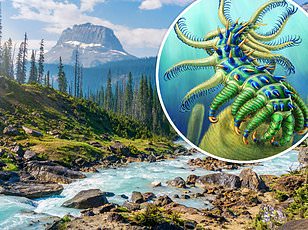A snorkeler was left in shock when she came face-to-face with an unusual sea creature while swimming in the blue waters around Mexico.
Susan Aide Morales Cruz has been documenting marine life around Playa Miramar for years, but only came in contact with a unique snail this month.
Footage of the dive captured a bright red sea hare swimming through the shallow waters of the Gulf of Mexico, leaving Morales Cruz 'hypnotized.'
Sea hares can be found in shallow, coastal waters where there is plenty of seaweed and marine plant growth to feed on which gives the creature its red-maroon coloring.

Sea hares look similar to snails and live in most marine waters around the world. They feed on alae and seagrass and often are red-maroon, green or brown

Susan Aide Morales Cruz (pictured) has been documenting marine life around Playa Miramar for years, but only came in contact with a unique snail this month
Morales Cruz lives in Ciudad Madero, a short distance from where she spotted the sea hare and described her encounter as nothing short of memorable.
‘That day, it was already late, and out of nowhere, I saw the sea hare coming as if it were flying through the great blue,’ she told Storyful.
‘It really hypnotized me, and I went swimming behind it. I began to record it and followed it for a long time, maybe 30 minutes.’
The minute-long video showed Morales Cruz tracking the creature that can grow up to seven inches.
Sea hares have structures on their head called rhinophores that can taste molecules in the water current, helping the creature search for food.
‘It is rare to find this species here where I live,’ Morales Cruz said.
‘It was a wonderful scene, the combination of the majesty of the animal and the sunset. A very memorable moment.’
Sea hares are found in most marine waters around the world where there isn’t a strong current and feed on algae and seagrass and have a range of colors including red-maroon, green and brown.
Despite being called a marine snail, sea hares have evolved to possess small internal shells but don’t have external shells like their land-based namesake.
These curious creatures have an average lifespan of one year, starting when they hatch from their eggs and begin as larvae.
At about two months old, they reach full maturity and can start reproducing at about seven months.

Sea hares have an average lifespan of one year, starting when they hatch from their eggs and begin as larvae. At about two months old, they reach full maturity and can start reproducing at about seven months

Sea hares can be found in shallow , coastal waters where there is plenty of seaweed and marine plant growth to feed on which gives the creature its red-maroon coloring
Like the land-based snail, sea hares are hermaphrodites and can serve as both the male and female during mating.
The creatures typically reproduce in large groups of 20 or more, and each sea hare produces millions of eggs that hatch after about two weeks.
Sea hares help the marine ecosystem because by feeding on seaweed and algae, they keep the plants in balance so other species can exist.
They aren't considered threatened or endangered but their population is at risk of declining due to ocean acidification, climate change and coastal development.
Ocean acidification is caused by carbon dioxide emissions which are absorbed by seawater which makes it more acidic and can eat away at underwater animals’ outer shells.
But if the creatures decline, ‘overgrowth and ecological imbalance is a serious concern,’ according to the National Marine Sanctuary Foundation.
This ‘can lead to consequences that have effects on human society, including changes in seafood availability, water quality, and partial ecosystem collapse.’




















































































































































































































































 City birds such as ducks and crows are carriers of potentially deadly antibiotic resistant bacteria, study finds
City birds such as ducks and crows are carriers of potentially deadly antibiotic resistant bacteria, study finds